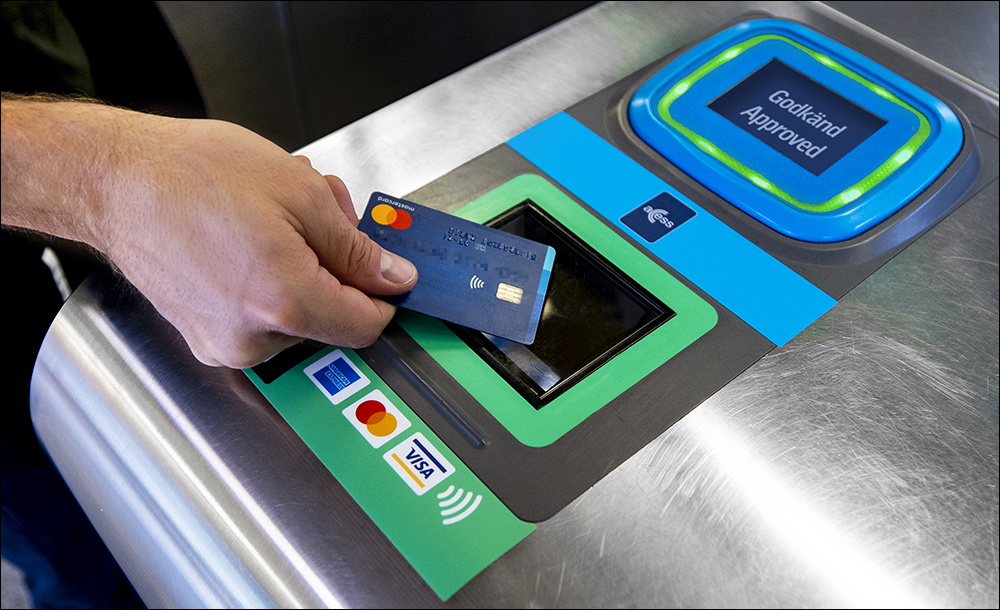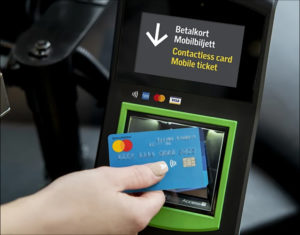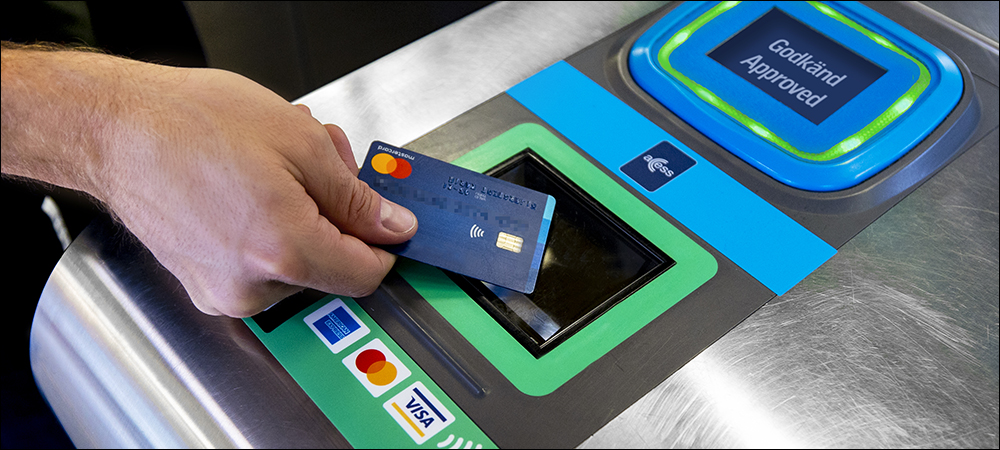Stockholm public-transit agency Storstockholms Lokaltrafik (SL) has launched a contactless payment system throughout the Swedish city using built-in Near Field Communication (NFC) technology, leveraging readers from Access-IS, a division of HID Global. The solution consists of the technology company’s recently developed ATR220-TripTick reader, built into gates that can capture payment data from bus and train passengers using their mobile phones or a Europay, Mastercard and Visa (EMV) SL green card with a built-in contactless NFC chip.
SL first deployed the system in 2019 for 2D barcode-based mobile ticketing with Access-IS ticket readers. The solution enables passengers to download an SL app, create an account for automated payment using a digital wallet, and receive a barcode that could be scanned as they enter the train or bus system. As the technology was being deployed, Access-IS was developing a new product that accommodates not only barcodes, but also 13.56 MHz NFC tags compliant with ISO 14443, as well as contactless EMV cards.

The ATR220-TripTick reader is intended to offer versatility for transit agencies and cities, says Cliff Hunter, Access-IS’s head of sales for transport and ticketing, so that they can provide multiple options for payments, or launch a system simply with barcodes, then expand to EMV and NFC. The device includes Power-over-Ethernet (PoE) connectivity and can be used with other Access-IS products that can be linked wirelessly to a server via a Wi-Fi or GSM cellular connection. The device can read the unique ID number of a barcode or NFC tag via mobile phones, tablets, wearables, contactless cards and paper tickets.
SL runs all land-based public-transport systems in Stockholm County. The city-owned company has been serving transit customers’ needs since it launched in 1915 for tram access, and it now provides bus and rail transit using SL’s own trains and privately operated bus companies. Almost 800,000 people use its services for commuter and local trains, buses and metro services. The NFC system for mobile payments was launched early this year, and SL released its SL Kort card—a green plastic card that users can acquire for season and weekly tickets utilizing EMV technology—this spring. The card serves as a prepaid account that can store up to two tickets so multiple passengers, such as parents and children, can use it.
The project was unique in several ways, SL reports. Stockholm was among the first cities to offer a contactless payment system capable of accommodating NFC, EMV and 2D barcodes, and SL chose to deploy the solution itself by engineering its own software and integration to payment services. More commonly, Hunter says, a city leverages a third-party solution provider. “They made a strategic decision to have their own home-built solution,” he states.
The ATR220-TripTick readers were deployed last year, including 850 gates, 200 ticket booths and 2,300 buses. To use the system, passengers can download the SL app from Google Play or Apple’s App Store, then make payments to create their digital wallet—just as they were previously doing—using all major payment schemes, along with Apple Pay, Samsung Pay or Google Pay.
Users need not have the app open to operate the system, SL reports. At metro and train gates, users can simply take out their phone, wearable device or ticket and tap it near the reader symbol. In that way, they can avoid having to touch anything but their own device. The reader captures the unique ID number related to a given passenger’s account and links that data to the payment service. The individual is then authorized to proceed through the gate to the platform. At ticket kiosks, users can tap their device near the reader and utilize the touch screen to purchase a green card.

For instance, an adult with a smartphone could purchase additional tickets to be carried by children or others who lack a mobile phone. The readers are also installed on buses where passengers enter. The buses employ an Access-IS VAL 100 Ticket Validator device with a built-in ATR220-TripTick reader. They can simply tap the device, after which the system will validate the payment information and grant the individual entry. Data is typically forwarded to the company’s cloud-based server via a 4G modem or Wi-Fi once the bus returns to the depot.
Contactless payments have proliferated across cities for transit payments, Hunter says, enabling payments via a mobile app, as well as transit cards for those without mobile phones. The solutions tend to leverage either QR codes or NFC data transmissions. Having both barcode and NFC functionality, though, is more unique, he adds. Sweden, Norway and Finland have been among the early adopters of smartphone use for ticketing with barcodes and apps. “Scandinavia has been fairly advanced in that area,” he states.
With the ATR220-TripTick devices, Hunter reports, cities are beginning to launch systems that can grow from a single payment function to multiple options as a city or transit agency chooses. “The nice thing about this product,” he explains, “is they can deploy the unit before they are ready to go live with contactless payments”—for instance, with simple barcode functionality. When users are ready to adopt contactless payments, Access-IS can provide a software upgrade that it calls “remote key-injection,” without physically visiting the machines to deliver the secure keys required for contactless payments. “It’s a way of future-proofing your system.”
While SL and Access-IS worked closely to build this solution, Access-IS expects most deployments to be conducted with the help of third-party providers. “This has been a very good cooperative project,” Hunter says. “Our next step will be to make the system into a more turnkey process” for other customers. “Most cities will need a solution that is provided and easily deployed for them.” The technology can be used not only for transportation, but also for access and payments, such as parking, events and retail.
Numerous cities are currently in the planning stages of deploying the technology, Hunter says. “COVID-19 has been a key driver,” he states, since cities are seeking solutions that enable passengers to move quickly through entrances without congregating, and to do so without touching anything. Individuals in many countries, he adds, are being encouraged to forgo cash, thereby limiting contacts related to the handling of paper money, and thus inhibiting infection spread.
Many cities that have such planning under way are interested in a phased approach to their deployment, Hunter notes. “They may not be ready to start contactless yet,” he indicates, “and they don’t want to replace hardware at a later date, so this is a nice solution for that.”


